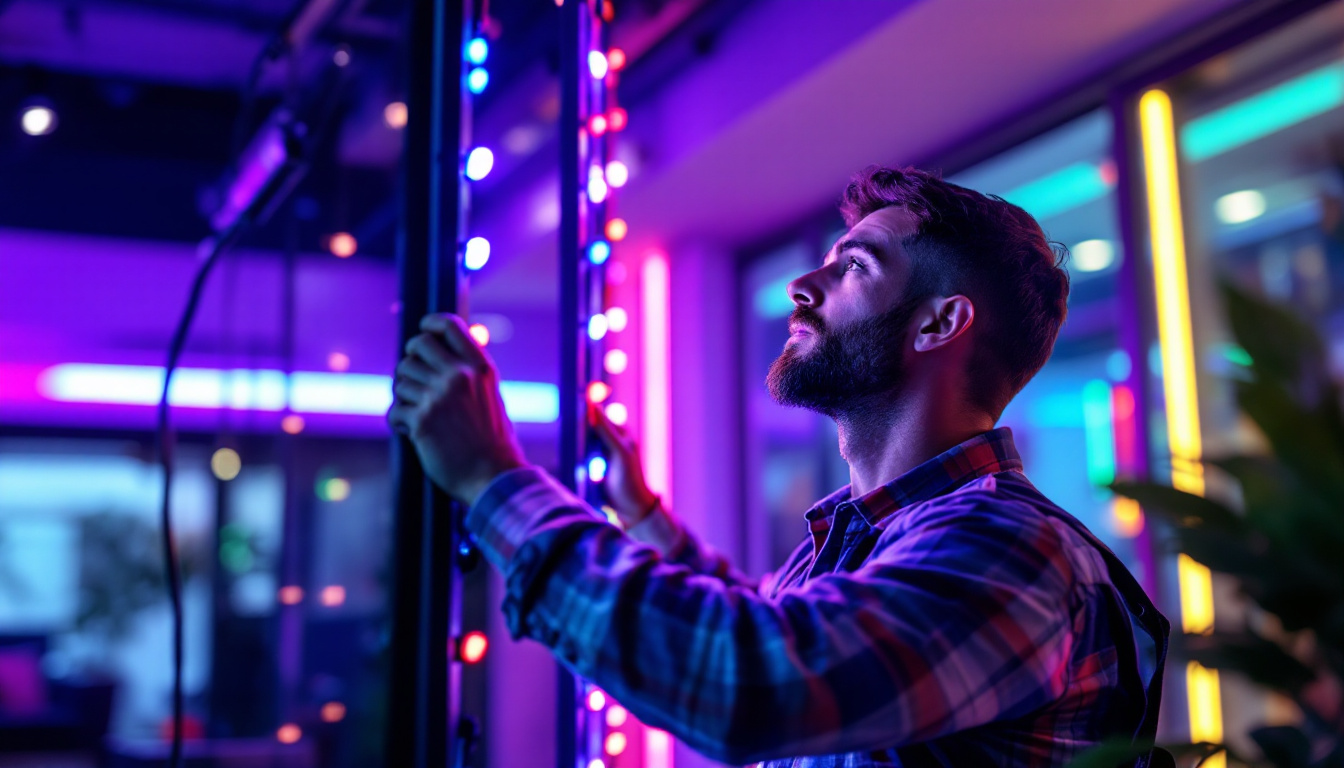
RGB LED lighting has transformed the landscape of modern lighting design, offering unprecedented versatility and creativity. For lighting contractors, understanding the intricacies of RGB LED technology is essential to delivering innovative solutions that meet client expectations. This article delves into the fundamentals of RGB LED lighting, its applications, and key considerations for contractors.
At its core, RGB LED lighting utilizes three primary colors—red, green, and blue—to create a spectrum of colors through additive color mixing. By adjusting the intensity of each color, a wide array of hues can be produced, making RGB LEDs a popular choice for both functional and decorative lighting. This versatility allows RGB LEDs to be employed in various settings, from residential homes to commercial spaces, enhancing ambiance and aesthetics.
Color mixing in RGB LEDs operates on the principle that combining different intensities of red, green, and blue light can yield various colors. For instance, when red and green are mixed at full intensity, the result is yellow. This principle allows contractors to create dynamic lighting effects that can be tailored to specific environments or events. Additionally, the ability to program specific color sequences and transitions opens up a world of creative possibilities, enabling designers to evoke different moods or themes through light alone. For example, a soft blue might create a calming atmosphere in a spa, while vibrant reds and greens could energize a party setting.
There are several types of RGB LED products available in the market, each designed for specific applications. Strip lights, for example, are flexible and can be installed in various locations, making them ideal for accent lighting. RGB bulbs can replace traditional light sources in fixtures, providing color-changing capabilities without the need for extensive rewiring. Additionally, RGB panels and wall washers offer a broader surface area for illumination, making them suitable for large spaces such as theaters or galleries. Understanding these options enables contractors to recommend the best products for their clients’ needs, ensuring that the lighting not only meets functional requirements but also enhances the overall design aesthetic.
Control systems play a crucial role in RGB LED installations. From simple remote controls to sophisticated DMX systems, the choice of control method can significantly impact the user experience. Contractors should be familiar with various protocols, such as DMX512 and DALI, to ensure seamless integration and functionality in their designs. Moreover, advancements in smart technology have introduced app-based controls and voice-activated systems, allowing users to manipulate their lighting with unprecedented ease. This integration with smart home systems not only enhances convenience but also offers opportunities for energy savings, as users can program their lights to operate only when needed, further promoting sustainability in lighting design.
The versatility of RGB LED lighting makes it suitable for a wide range of applications, from residential to commercial spaces. Understanding these applications allows contractors to better serve their clients and enhance their projects.
In residential settings, RGB LED lighting is often used to create ambiance and enhance aesthetic appeal. Homeowners can use color-changing lights to set the mood for different occasions, whether it’s a cozy dinner or a lively party. Contractors can suggest installations in areas such as living rooms, kitchens, and outdoor spaces to maximize the impact of RGB lighting. Additionally, RGB LED lighting can be programmed to sync with music, providing an engaging experience for gatherings or celebrations. Smart home integration also allows homeowners to control their lighting remotely, adjusting colors and brightness to suit their preferences at any time.
In commercial environments, RGB LED lighting can be utilized to attract customers and enhance branding. Retailers often use dynamic lighting displays to highlight products or create an immersive shopping experience. For contractors, understanding how to integrate RGB lighting into a store’s design can help drive sales and improve customer satisfaction. Furthermore, RGB LEDs can be strategically placed to guide customers through the store, using color cues to lead them to promotional items or seasonal displays. This not only enhances the shopping experience but also encourages impulse purchases, making it a valuable tool for retailers looking to maximize their sales potential.
Events and performances benefit greatly from RGB LED technology, as it allows for quick changes in lighting to match the theme or mood of the occasion. From concerts to corporate events, RGB LEDs can create stunning visual effects that captivate audiences. Contractors should be equipped with knowledge of temporary installations and portable systems to meet the demands of event lighting. Moreover, the use of RGB lighting in stage productions can help convey emotions and narratives, with color palettes that shift in harmony with the performance. This dynamic capability not only enhances the visual storytelling but also engages the audience on a deeper level, making the event memorable and impactful.
When it comes to installing RGB LED systems, several factors must be taken into account to ensure optimal performance and longevity. Contractors should be well-versed in these considerations to deliver high-quality installations. A thorough understanding of the environment where the LEDs will be installed is paramount, as factors such as ambient temperature, humidity, and exposure to elements can significantly impact the effectiveness and durability of the lighting system. For instance, outdoor installations may require weatherproof fixtures and additional protective measures to withstand harsh conditions.
RGB LED systems require a stable power supply to function effectively. Contractors must ensure that the voltage requirements of the LEDs match the power source to prevent flickering or damage. Additionally, understanding the wattage and amperage needs is crucial for selecting appropriate power supplies and ensuring safety. It is also advisable to consider the use of surge protectors to safeguard the system against voltage spikes, which can occur due to electrical storms or fluctuations in the power grid. This proactive measure can extend the life of the LEDs and maintain consistent performance over time.
Heat dissipation is another critical factor in RGB LED installations. Excessive heat can shorten the lifespan of LEDs and affect their performance. Contractors should consider using heat sinks and ensuring proper ventilation in their designs to mitigate these issues. In addition, implementing thermal management strategies, such as spacing the LEDs appropriately and using materials that enhance heat dissipation, can further protect the system. Regular maintenance checks can also be beneficial, as they allow for the identification of any overheating issues before they lead to significant problems.
Proper wiring is essential for the functionality of RGB LED systems. Contractors need to be familiar with the wiring configurations and ensure that connections are secure to prevent failures. Additionally, understanding the layout of the space can help in planning the most efficient wiring routes. It is also important to consider the use of connectors and junction boxes that are rated for the specific application, as this can improve reliability and ease of future maintenance. Furthermore, labeling wires and connections can save time during troubleshooting and repairs, making the system more user-friendly for both contractors and end-users.
Designing with RGB LED lighting requires a blend of creativity and technical knowledge. A well-thought-out design can elevate a space and provide a unique experience for users.
One of the most compelling aspects of RGB LED lighting is the ability to create dynamic scenes. By programming different color combinations and transitions, contractors can design lighting that adapts to various activities or moods. This capability is particularly valuable in commercial settings, where lighting can be adjusted to enhance customer experiences.
As smart home technology continues to evolve, integrating RGB LED lighting with these systems has become increasingly popular. Contractors should be familiar with platforms such as Zigbee or Z-Wave, which allow for seamless control of lighting through smartphones or voice commands. This integration can add significant value to residential projects.
Color psychology plays a vital role in lighting design. Different colors can evoke various emotions and responses, making it essential for contractors to consider the psychological effects of their lighting choices. For example, blue light is often associated with calmness, while red can stimulate energy. Understanding these implications can help contractors create more effective lighting solutions.
Maintaining RGB LED systems is crucial for ensuring their longevity and performance. Contractors should be prepared to address common issues that may arise during the lifespan of the installation.
Regular inspections of RGB LED installations can help identify potential problems before they escalate. Contractors should advise clients on the importance of checking connections, power supplies, and the condition of the LEDs themselves. Early detection of issues can save time and costs associated with repairs.
Common issues with RGB LED systems include flickering lights, color inconsistencies, and complete failures. Understanding the root causes of these problems is essential for effective troubleshooting. For instance, flickering may be due to inadequate power supply, while color inconsistencies could stem from faulty controllers. Being equipped with solutions ensures quick resolutions for clients.
As technology advances, older RGB LED systems may become outdated. Contractors should stay informed about the latest developments in LED technology and be prepared to recommend upgrades or replacements when necessary. This proactive approach can enhance client satisfaction and ensure that installations remain cutting-edge.
RGB LED lighting offers a wealth of opportunities for lighting contractors to innovate and elevate their projects. By understanding the technology, applications, installation considerations, design principles, and maintenance practices, contractors can provide exceptional service and solutions to their clients. As the demand for dynamic and customizable lighting continues to grow, staying informed and adaptable will be key to success in this ever-evolving field.
Ready to take your lighting projects to the next level? At LumenWholesale, we provide lighting contractors with an exceptional range of top-quality, spec-grade RGB LED lighting products at unbeatable wholesale prices. Say goodbye to inflated markups and hello to superior lighting that meets the highest industry standards. With our hassle-free bulk buying options and free shipping, you can trust that you’re getting premium lighting at the best value — without any hidden fees or compromises. Elevate your lighting designs with the perfect blend of quality, affordability, and convenience. Discover the difference with Wholesale Lighting at the Best Value today!

Discover why lighting contractors should prioritize electric ballasts in their projects.

Discover the essential do’s and don’ts for lighting contractors when purchasing stadium lights.

Discover why LED emergency lights with battery backup are the essential yet often overlooked component in lighting projects.

Discover the essential checklist for lighting contractors when installing LED residential garage lights.